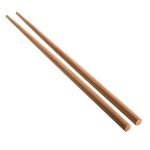 The original and ancient Chinese name for chopsticks was tsze, meaning help, since the utensils assisted in getting the food from your dish to your mouth. However, the Chinese eventually replaced this name with a term that sounded similar, but seemed to better describe the motion of the chopsticks: k’waitsze, meaning the quick ones. British sailors, returning from voyages to the Orient in the late seventeenth century, rendered this unfamiliar term into English as chop and then combined it with stick to create the word chopstick. More than two centuries later, the Chinese k’wai, meaning quick, was again rendered into English in the phrase chop chop, meaning quick quick or, more idiomatically, make it snappy. The chop in chop suey, however, derives from a completely different Chinese source: the Cantonese shop sui, meaning bits and pieces. This dish did not originate in China but rather on the west coast of the United States where it was invented by Chinese immigrants engaged in building railroads. Neither of these Chinese chops, of course, is related to the chop in pork chop.
The original and ancient Chinese name for chopsticks was tsze, meaning help, since the utensils assisted in getting the food from your dish to your mouth. However, the Chinese eventually replaced this name with a term that sounded similar, but seemed to better describe the motion of the chopsticks: k’waitsze, meaning the quick ones. British sailors, returning from voyages to the Orient in the late seventeenth century, rendered this unfamiliar term into English as chop and then combined it with stick to create the word chopstick. More than two centuries later, the Chinese k’wai, meaning quick, was again rendered into English in the phrase chop chop, meaning quick quick or, more idiomatically, make it snappy. The chop in chop suey, however, derives from a completely different Chinese source: the Cantonese shop sui, meaning bits and pieces. This dish did not originate in China but rather on the west coast of the United States where it was invented by Chinese immigrants engaged in building railroads. Neither of these Chinese chops, of course, is related to the chop in pork chop.
